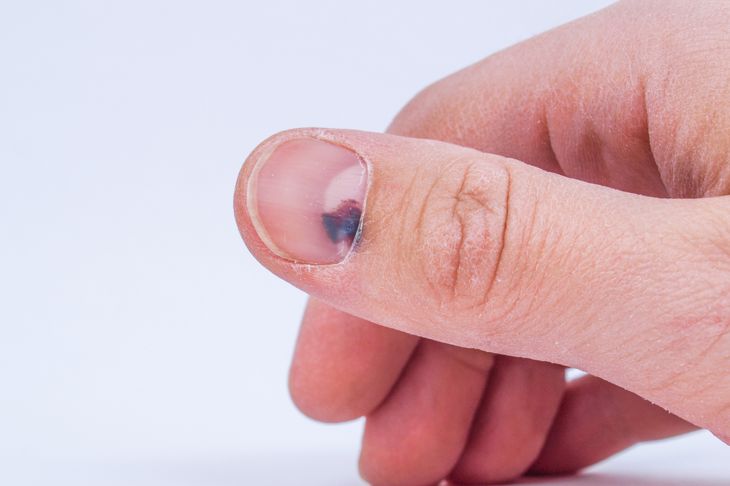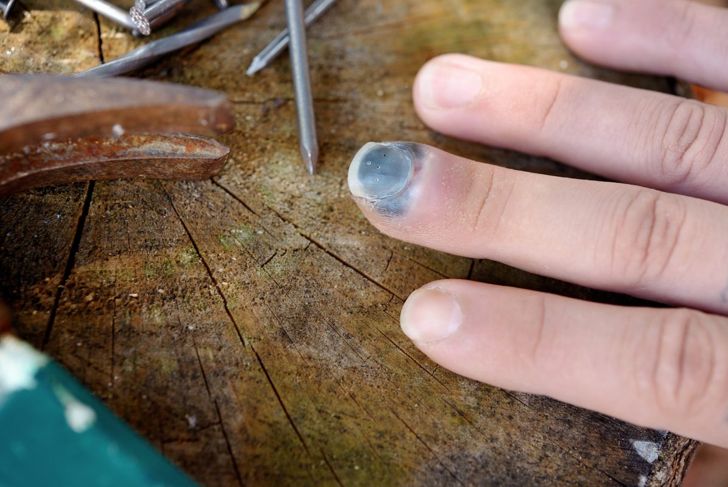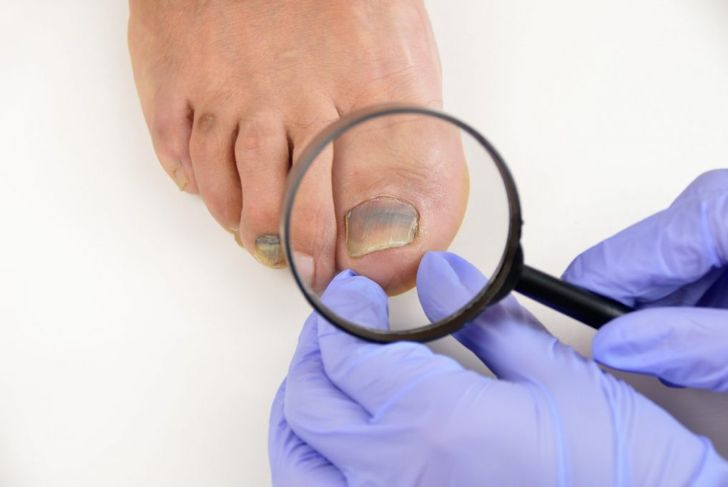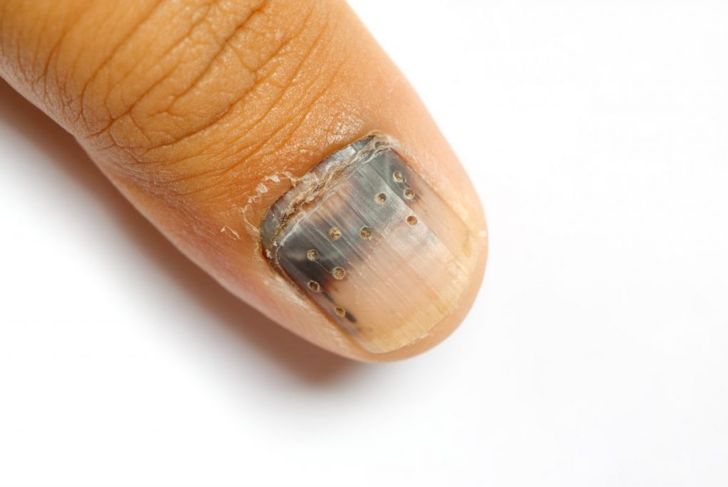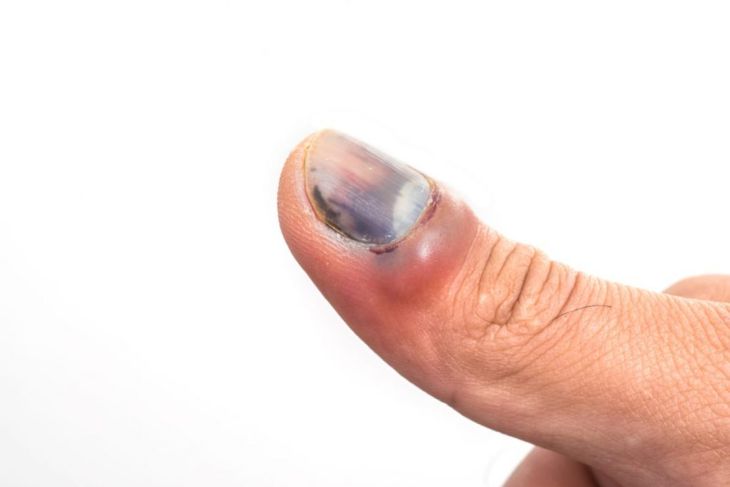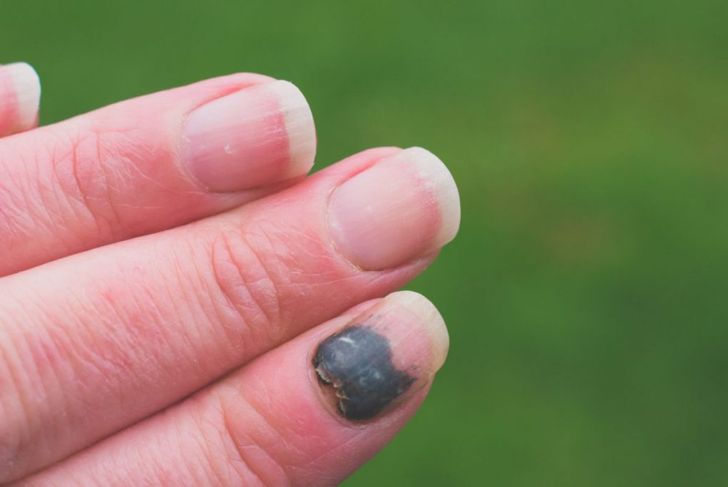A subungual hematoma is a small collection of blood (hematoma) between the nail bed and the nail. It initially appears as a purple area but turns black after a few days. Subungual hematomas may result from a single injury to the nail or from chronic trauma and cause severe, throbbing pain. Despite this, the condition is not serious, and a variety of treatment options are available depending on the size of the hematoma.
Causes
Subungual hematomas can be caused by a single, acute injury that crushes the tip of the finger or toe, such as a blow from a hammer, the impact of a heavy object, or slamming the finger in a door. Repetitive trauma to the nail, such as ill-fitting shoes, can cause the injury over time. Athletes are particularly at risk, as the running motion forces the toes into the front of the shoe — this is sometimes called “runner’s toe.” Trauma to the nail bed causes the small blood vessels to bleed into the area underneath the nail.
Symptoms and Signs
The most common symptom of a subungual hematoma is severe pain in the nail bed. The area under the nail is restricted, and as the blood builds up, the pressure increases, causing throbbing pain. A blackish discoloration will develop under the nail in the days following the injury, and the nail may start to lift from the nail bed. A rich blood supply is delivered to the nail bed and its high density of nerves — this is why subungual hematomas are so painful. The nail is firmly attached to the tip of the digit, and there is little fatty tissue to absorb the increasing blood. The bleeding rapidly places pressure on the nerve endings, resulting in intense and throbbing pain.
When to Seek Medical Care
Minor subungual hematomas will usually heal on their own, but if the area of discoloration is greater than 50% of the nail bed, if the bleeding does not stop, or if the pain becomes unbearable, then a doctor should investigate. If the cause is a crush injury, there could be other damage to the digit. Doctors may order x-rays to identify fractures. If a baby or child develops a hematoma of any size, they should be taken to the doctor.
Simple Treatments
Elevation and application of an icepack can manage minor cases, reducing the swelling of the hematoma and the surrounding tissues. Ice should not be applied directly to the skin but be wrapped in a towel. Wrapping a bandage around the finger or toe can help limit the amount of blood that pools under the nail. Over-the-counter painkillers should be adequate in most minor cases.
Medical Treatment
If the pain from the hematoma becomes intolerable despite simple treatment, the only option is to release the pressure under the nail by draining the blood or by removing the nail entirely. The drainage procedure, trephining, involves creating a small hole or holes above the hematoma to allow the blood to drain out. This can be done with a drill, cautery, scalpel or, less commonly, a laser. Removal of the entire nail may be necessary if it is badly damaged or there are lacerations around the area. Depending on the severity and the plan for treatment, doctors may use a digital nerve block or local anesthesia to painlessly remove the nail.
Prevention
A subungual hematoma is a common and usually minor injury. Individuals can avoid those due to accidental blows to the fingers and toes by following safety precautions such as steel-toed boots in the workplace. For hematomas caused by ill-fitting running footwear, the solution is to improve the fit of the shoe. Silicone toe protectors inserted into athletic shoes may also help. Keeping toenails clipped short will reduce the risk of undue pressure on the nail and nail bed.
Complications
Subungual hematomas can result in complications such as infection if a doctor does not attend to a more serious injury. Infections cause inflammation and swelling of the surrounding tissues, and pus may accumulate around the nail bed. This situation may require antibiotics and possibly removal of the nail.
Recovery
If the subungual hematoma is minor and medical attention has not been necessary, then the collection of blood will resolve spontaneously over a few weeks, and new nail growth may take between six and nine months. If the injury is more severe, particularly if the nail bed has been traumatized, the nail may grow back with a permanent deformity.
Those at Risk
Blood-thinning medications increase the likelihood of bleeding following nail trauma, and prolonged bleeding can lead to a rapid build-up of blood under the nail. People on these medications need to be extra vigilant when there is any risk of trauma to fingers and toes. Acrylic nails can cause risks after injury by obscuring the early signs of discoloration, leading to a delay in diagnosis.
Alternative Diagnoses
Melanomas can occur under a fingernail or toenail and be mistaken for a subungual hematoma, particularly if there has been some trauma to the area. Melanomas of the nail bed have distinctive characteristics, and their diagnosis needs the expertise of a dermatologist.

 Home
Home Health
Health Diet & Nutrition
Diet & Nutrition Living Well
Living Well More
More